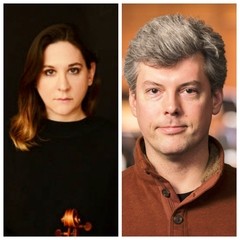|
Back
Ligeti: Words, Music and Magic New York
Zankel Hall, Carnegie Hall
03/16/2018 -
“This Music Should Not Exist”:
György Ligeti: Continuum – Piano Concerto – Chamber Concerto for Twelve Instruments – Excerpts from Kyrie, Requiem & Poème symphonique
Sir Charles Chaplin: From Modern Times: “Factory Music” (arranged by Courtney Orlando)
Karlheinz Stockhausen: Kontra-Punkte
Anton Seifert: Kärntner Liedermarsch
Steven Beck (Harpsichord), John Orfe (Piano), Nadia Sirota (Viola, Co-writer, Co-Host)
Alarm Will Sound, Alan Pierson (Conductor, Co-Writer, Co-Host)

N. Sirota/J. Orfe (© Sherwin Ainez/Courtesy of the Artist)
“How about composing a piece that would be a paradoxically continuous sound…but consist of innumerable thin slices of salami?”
György Ligeti on his own Continuum (1968)
Neither Richard Wagner, Hector Berlioz or György Ligeti were very good piano players. Wagner, though, created through the theater. Berlioz created through the flute and the orchestra.
And György Ligeti? According to conductor Alan Pierson and violist Nadia Sirota last night, Ligeti created his massive, complex, whirling, scores solely through the mind. And the experience of the mind. Of being trapped and alone. Like Mahler, a Hungarian from another country and being a Jew in a land of anti-Semites.
Mahler’s spirituality and mysticism erupted in every note he ever wrote. Ligeti, though, was a question mark. Yet in this utterly fascinating concert of music and biography, too-clever scripting, and sometimes questionable conclusions, one begins to get an idea from whence Ligeti came and where he was reaching throughout his life.
Conductor Pierson had one distinct advantage in the Ligeti litany. He had the players of Alarm Will Sound. Players who, in the midst of the most complex Ligeti scores, were transparent, on edge, stunning in the most quantum-based score. Without a baton to guide him, Mr. Pierson seemed to cue in every player in the Chamber Concerto. But truth be told, these players needed no signals. They had their music down pat.
The other advantage was a script written by both Pierson and Sirota. It was a bit too cute (all the musicians picking up metronomes, or making trekking sounds to show Ligeti’s escape from the Hungarian Army). But for those who didn’t know the composer’s story, they told it.
In words, and all too rarely, music. The words, spoken by these two, as well as orchestral members, related Ligeti’s upbringing, his family taken to concentration camps, himself unable to get into the University for science because of his Judaism, so going to the Conservatory–as a second choice.
And then his military labors, his escape to Vienna and finally Paris. The last part of his life was only hinted at, because the Pierson-Sirota team seemed to feel that his nightmarish travails at the start of his life were to become the background for much of his music.
That was, of course, an oversimplification, as they would admit. So was the simile of Chaplin’s “Factory Music” from Modern Times to Ligeti’s own chugging music. (Mosolov and the Italian Futurists were more appropriate than Sir Charles.)
Added to this were snippets of Stockhausen (coming as radio static) a Communist march and other trivialities. None of which said much about Ligeti himself. Especially because he was never a very comfortable member of the Stockhausen Darmstadt School.
So instead of a few of the hundreds of examples, Mr. Pierson and Alarm Will Sound gave us three masterful Ligeti examples.
First was Continuum, performed on the harpsichord by Steven Beck. Nothing can be considered “typical” Ligeti, but with only a single instrument, one could feel instinctively the three dimensions: the composer’s set of paradoxical rhythms. Of clattering on the outside, of pitch and rhythmic changes, and meters going up and down so quickly, yet with a slow slow pace.
Steve Reich has written similar music, but Ligeti’s piece has the most varied changes.
The final work, with little introduction was the Chamber Concerto played by the 13 Alarm Will Sound instrumentalists. We had again all these maddening changes of pitch and rhythm. But here, each of the four movements seemed to organically blossom from each cell. It was a gentle blossoming, less frenetic than the Continuum, more...
Well, more like Béla Bartók’s work. More than the Stockhausens or Boulez’s, Ligeti idolized Bartók, and the Chamber Concerto, again with that unnervingly precise playing, was like a series of four creations. Whatever the complexity of Ligeti’s notions, one feels that a very organized form is behind it. Not the cryptic even vacuous forms of Darmstadt, but those of a very human gentleman who wants to enthrall.
The Piano Concerto was John Orfe’s great moment, though he was very much part of the ensemble. I had never heard it before, but here it seemed five movements of fractals, simultaneous rhythmic divisions clashing seamlessly, sometimes with Stravinskyan percussiveness, and always with the presto prestissimo virtuosity.
As a member of Alarm Will Sound, Mr. Orfe was part of that tradition of pinpoint accuracy. And Mr. Pierson directed both the soloist and ensemble with what only be described as subatomic alacrity.
Harry Rolnick
|